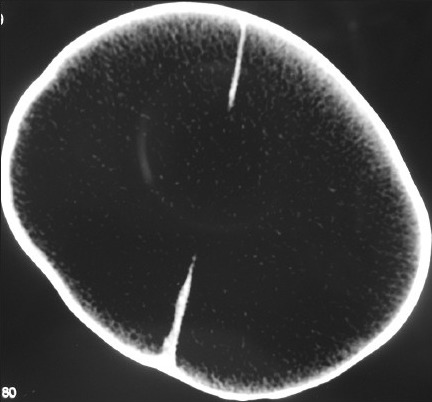Dear Sir,
Spontaneous rupture of hydrocephalous is an odd phenomenon. It is more marked in infants who remain untreated for long time despite having rapidly enlarging head size. Here we report such a case of spontaneous rupture of huge hydrocephalic head in an infant and discuss the possible pathophysiology.
An 8-month old female baby, born at full term by normal vaginal delivery at local hospital, presented to our department with severe progressive increase of head size and a swelling in lumbosacral area since birth. In the antenatal period, she was diagnosed to have hydrocephalus at 6 months of gestation and advised for termination by local doctor, but her mother refused for termination and continued till delivery. She was born with a large head and a lump in the lumbar region, both kept on increasing gradually. She also had weakness in both lower limbs since birth. She was diagnosed to have meningomyelocele (MMC) and congenital hydrocephalous and was advised for the repair of MMC and ventriculoperitoneal shunting. Due to poor financial status and illiteracy of her parents, she was kept at home without proper treament. At 8 month of age, when she presented to us, she had large head (HC-72 cm) with multiple scalp pressure necrosis [Figure 1] leaking cerebrospinal fluid (CSF). Physical examination revealed a lumbosacral MMC of size - 8 × 6 cm [Figure 2] with bilateral club foot and lower limb power 0/5. She was running fever and her total leucocyte count was raised. Non-contrast computed tomography head revealed large hydrocephalus [Figure 3]. Right side medium pressure ventriculoperitoneal shunt insertion was planned on urgent basis. But, while waiting for surgery, she developed dehiscence of the skin over the vertex with CSF leakage from it without any form of preceding trauma [Figure 4] and eventually resulted in spontaneous rupture of head and death.
Figure 1.

Clinical photograph of the patient showing large head size
Figure 2.

Clinical photograph of the patient showing meningomyelocele defect in the lumbosacral region
Figure 3.

Non-contrast computed tomography head showing large hydrocephalus with thin rim of cerebral mantle
Figure 4.

Photograph of the patient after spontaneous rupture of head showing sunken scalp and sutural margin
In rural parts of developing countries like India, few cases of hydrocephalus still remain untreated despite the widespread awareness and availability of neurosurgical services. Spontaneous rupture of hydrocephalous is an odd phenomenon. Occasionally, long-standing tension hydrocephalus can lead to formation of ventricular diverticula[1] or ventricular rupture. It can rupture into cisterns leading to spontaneous ventriculostomy[2] or may rupture through necrotic scalp skin leading to ‘spontaneous brain rupture’. Only in infantile huge hydrocephalus, spontaneous brain rupture may occur where the skull is expandable and the sutures are not closed.
In infantile hydrocephalus, enlargement of head size occurs due to non-union of cranial sutures. When ventricular enlargement occurs there is thinning of cerebral parenchyma and further enlargement leads to thinning of skin and subcutaneous tissue. Because of large size and weight of the head, there is difficulty in placing the head on bed leading to skin pressure, ulcers and even infection at time. In cases of untreated ventricular distension, this promotes CSF leakage and rupture of head. A combination of internal biomechanical forces as a result of ventricular expansion and external mechanical irritation due to trauma to thinned skin leads to spontaneous rupture of brain in long standing neglected cases.[3] So increased awareness amongst the parents, early neurosurgical consultation and prompt surgical management is required to prevent spontaneous rupture of brain in case of rapidly progressing congenital hydrocephalus.
References
- 1.Garg K, Mahapatra AK. A rare case of ventricular diverticulum in a child with occipital encephalocele. Pediatr Neurosurg. 2012;48:26–9. doi: 10.1159/000341726. [DOI] [PubMed] [Google Scholar]
- 2.Mahapatra AK. Spontaneous ventriculocisternostomy. Indian J Pediatr. 1985;52:93–5. doi: 10.1007/BF02754727. [DOI] [PubMed] [Google Scholar]
- 3.Garg K, Gurjar HK, Singh PK, Satyarthee GD, Singh M, Chandra PS, et al. Spontaneous rupture of hydrocephalic head. Neurol India. 2013;61:556–8. doi: 10.4103/0028-3886.121955. [DOI] [PubMed] [Google Scholar]


